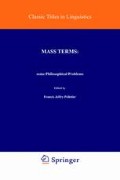Abstract
From early childhood we learn to distinguish compact, enduring things from the stuffs of which they are constituted. We count the former and measure the latter. We treat things as stable points of reference for action and experience; stuffs we think of as amorphous and protean.
I am indebted to many people — especially to Robert Adams, John Perry, Warren Quinn, and John Wallace.
Access this chapter
Tax calculation will be finalised at checkout
Purchases are for personal use only
Preview
Unable to display preview. Download preview PDF.
Notes
Good informal discussion of aspects of the Aristotelian problem may be found in David Wiggins, Identity and Spatio-Temporal Continuity (Basil Blackwell, Oxford, 1967). On the Heraclitean problem, see W. V. Quine, `Identity, Ostension, and Hypostasis’, From a Logical Point of View (Harvard U. P., Cambridge, Mass., 1953), pp. 65–70; Word and Object (MIT Press; Cambridge, Mass., 1960), pp. 116, 171; Helen Morris Cartwright, `Heraclitus and the Bath Water’, Philosophical Review 74 (1965), 466–485; John Perry, `The Same F’, Philosophical Review 79 (1970), 181–200. In what follows I shall use `physical object’ to apply to anything which (from some assumed point of view) may be an object of reference, which is physical, and which is not an event. On our favored account, the terms `stuff’ and `thing’ will be construed as having roughly disjoint extensions each of which is included in that of `physical object’.
There are cases in which gradual change of parts seems to involve change in identity. Imagine that smugglers gradually dismantle a valuable, historic steel engine, replace its parts one by one with aluminum ones (to fool the authorities), and ship the original parts across the border where they are reassembled. I shall assume that such examples do not show that in all cases of complete part replacement, the identity of the whole is altered.
This handling of mass terms is perhaps suggested by Aristotle’s paraphrase of them into adjectives, Metaphysics IX,7. The Relational Approach may be fairly characterized as treating substantivais on the model of adjectives.
A position between our approaches is that of D. Gabbay and J. M. Moravcsik, `Sameness and Individuation’, The Journal of Philosophy 70 (1973), 513–526. The position treats mass terms and count nouns as one-place predicates true of functions from times to a substratum. Thus, portions of gold, tables, animals, and mountains are taken to be abstract objects. The excuse for this view is the unelaborated claim that it helps explain the sense in which physical objects are `constructions’. But it is left unclear why such explanation requires identifying physical objects with functions rather then merely holding that for each physical object there is a function from times to some substratum that mirrors the object in the appropriate way.
The schema is an offspring of Aristotle’s so-called logical criterion for substance. Cf. Categories 4a, 10–11.
I use `thread’ instead of `worm’ because stuff can be spatially scattered (unraveled). I do not intend `thread’ to rule out even temporal discontinuity, but metaphors that make such a possibility four-dimensionally picturesque are scarce.
I shall not argue for my representation of tense since it has no very deep bearing on the main issues of the paper. (For the argument see my `Demonstrative Constructions, Reference, and Truth’ The Journal of Philosophy 71 (1974), 205–223.) If we had used a tense-logic to represent English sentences, the same issues could have been developed by focusing on the metalanguage. I am willing to take `Exists at t’ as primitive, although as applied to physical objects it could be defined as `occupies some place at time t’.
Cf. note 3. Richard Rorty in `Genus as Matter’ in Exegesis and Argument: Essays in Greek Philosophy Presented to Gregory Vlastos,Edward Lee et. al. (eds.), Van Gorcum, Assen, The Netherlands, speculates that Aristotle’s physical criterion for substance and his treatment of stuffs as `mere potencies’ were partly motivated by a desire to block reductionist ontologies which result from pushing the logical criterion for substance (essentially (NP)) to the point of counting only ultimate substratum as substance, cf. Metaphysics VII, 16. For criticism of more recent moves analogous to Aristotle’s, see Helen Morris Cartwright, `Quantities’, Philosophical Review 79 (1970), 25–42; Henry Laycock, `Some Questions of Ontology’, Philosophical Review 81 (1972), 3–42; and my `Truth and Mass Terms’, Journal of Philosophy 69 (1972), 263–282, esp. sections II-IV.
Quine occupies this ground in Review of Geach’s Reference and Generality, Philosophical Review 73 (1964) 102. I assume that everyone would agree that water which does not exist while Heraclitus bathes is irrelevant to determining what water he bathed in.
This is equally a difficulty for attempts to reconstruct our practice of counting by appeal to some sort of equivalence relation among the relevant stages. The problem is to state the equivalence relation without relying on the monadic `kind’ predicate.
Reasons for this claim stem from Nelson Goodman’s work on simplicity. See The Structure of Appearance (Bobbs-Merrill, New York, 1951), 2nd edition, pp. 63–123.
This paper has dealt only with account-types. A closer examination of stuffs suggests that some of them are plausibly construed on the model of phases of more basic stuffs. Cf. `A Theory of Aggregates’, forthcoming in Nods.
Author information
Authors and Affiliations
Editor information
Editors and Affiliations
Rights and permissions
Copyright information
© 1975 Springer Science+Business Media Dordrecht
About this chapter
Cite this chapter
Burge, T. (1975). Mass Terms, Count Nouns, and Change. In: Pelletier, F.J. (eds) Mass Terms: Some Philosophical Problems. Synthese Language Library, vol 6. Springer, Dordrecht. https://doi.org/10.1007/978-1-4020-4110-5_14
Download citation
DOI: https://doi.org/10.1007/978-1-4020-4110-5_14
Publisher Name: Springer, Dordrecht
Print ISBN: 978-1-4020-3265-3
Online ISBN: 978-1-4020-4110-5
eBook Packages: Springer Book Archive

